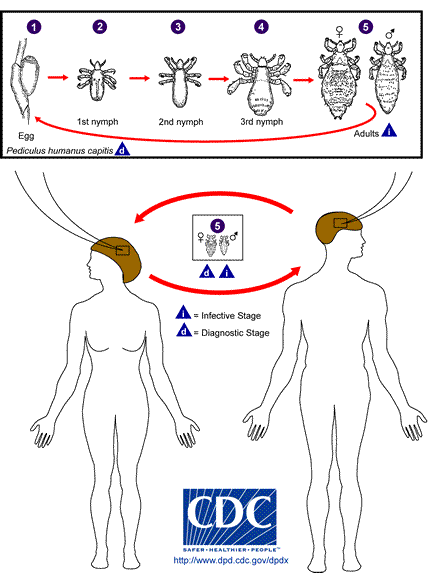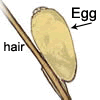Pediculosis capitis pathophysiology
|
Pediculosis capitis Microchapters |
|
Diagnosis |
|---|
|
Treatment |
|
Case Studies |
|
Pediculosis capitis pathophysiology On the Web |
|
American Roentgen Ray Society Images of Pediculosis capitis pathophysiology |
|
Risk calculators and risk factors for Pediculosis capitis pathophysiology |
Editor-In-Chief: C. Michael Gibson, M.S., M.D. [1]
Overview
The main mode of transmission is contact with a person who is already infested (i.e., head-to-head contact). Contact is common during play (sports activities, playgrounds, at camp, and slumber parties) at school and at home.
Pathophysiology
Life cycle:

The life cycle of the head louse has three stages: egg, nymph, and adult.
- Eggs: Nits are head lice eggs. They are hard to see and are often confused for dandruff or hair spray droplets. Nits are laid by the adult female and are cemented at the base of the hair shaft nearest the scalp 1. They are 0.8 mm by 0.3 mm, oval and usually yellow to white. Nits take about 1 week to hatch (range 6 to 9 days). Viable eggs are usually located within 6 mm of the scalp.
- Nymphs: The egg hatches to release a nymph 2. The nit shell then becomes a more visible dull yellow and remains attached to the hair shaft. The nymph looks like an adult head louse, but is about the size of a pinhead. Nymphs mature after three molts (3, 4) and become adults about 7 days after hatching.
- Adults: The adult louse is about the size of a sesame seed, has 6 legs (each with claws), and is tan to grayish-white 5. In persons with dark hair, the adult louse will appear darker. Females are usually larger than males and can lay up to 8 nits per day. Adult lice can live up to 30 days on a person’s head. To live, adult lice need to feed on blood several times daily. Without blood meals, the louse will die within 1 to 2 days off the host.
-
Egg on a hair shaft
-
Nymph form
-
Adult louse
Transmission
Personal hygiene or cleanliness in the home or school has nothing to do with getting head lice. Getting head lice is not related to cleanliness of the person or his or her environment. Head lice are mainly spread by direct contact with the hair of an infested person. The most common way to get head lice is by head-to-head contact with a person who already has head lice. Such contact can be common among children during play at:
- School,
- Home, and
- Elsewhere (e.g., sports activities, playgrounds, camp, and slumber parties).
Less commonly,
- Wearing clothing, such as hats, scarves, coats, sports uniforms, or hair ribbons, recently worn by an infested person.
- Using infested combs, brushes, or towels.
- Lying on a bed, couch, pillow, carpet, or stuffed animal that has recently been in contact with an infested person.


